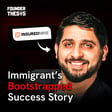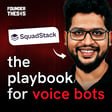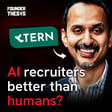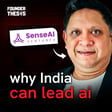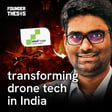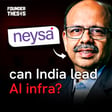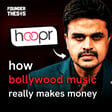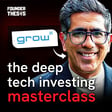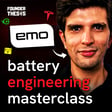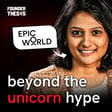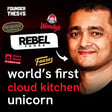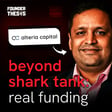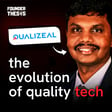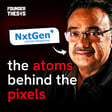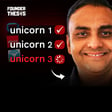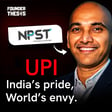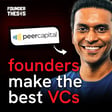Become a Creator today!Start creating today - Share your story with the world!
Start for free
00:00:00
00:00:01

Enabling better health outcomes at scale | Vishal Gondal @ GOQii
GoQii is a leader in the health-tech space, having raised more than 100 mn dollars till date from top VCs. Vishal leveraged his understanding of gaming to make gamification the heart of Goqii. He recollects his journey of building GoQii as a second-time founder.
Insights shared:-
- GTM and pricing of health tech products and services
- How healthcare management differs from insurance
- Metrics of a health tech business
- Don’t find structure- advice for aspiring founders
Additional links:-
Transcript
Introduction of Vishal Gondal and His Journey
00:00:12
Speaker
I'm sure you would have heard the saying, if I can see further, it is because I stand on the shoulders of giants. And once a giant of the Indian tech startup ecosystem is Vishal Gondal. Don't miss the first part of his conversation which covers Vishal's journey from the late 90s to 2012 when he sold his startup to Disney for almost $100 million.
00:00:33
Speaker
In this part, Vishal talks about his journey into fitness and the birth of his startup, Gokhi, that is on a mission to make people fitter by using smart technology. Gokhi is a leader in the health tech space, having raised more than $100 million till date from top VCs and impacting millions of lives. Vishal leverages understanding of gaming to make gamification as the heart of Gokhi, and in this episode, he tells Akshay Dutt about the journey of building Gokhi as a second-time founder.
00:01:02
Speaker
Stay tuned and subscribe to the Founder Thesis Podcast on any audio streaming platform to learn how second time founders go about building their next big thing.
Vishal Gondal's Personal Health Transformation
00:01:18
Speaker
And Boki's story again goes back to the same story. So when I was in college, I was a national level volleyball player. But running India Games, I used to weigh 120 kgs. I was extremely obese, unhealthy. I had all kinds of healthy shoes and I was like, how do I become healthy? And 2011 is when I started my health journey.
00:01:37
Speaker
Of course, I went to the gym and died. What worked for me was, when I started working with a coach, who used to message me and tell me, do this, do that, and being a techie, I had all kinds of... I had the Fitbit, I had all kinds of measuring devices, everything. And I used to send that data to my coach, and my coach used to train me. And what I realized is that...
00:01:58
Speaker
I ended up, by the way, running 14-15 half marathons. I have done ultra marathons. I have even trekked to Everest Base Camp.
The Role of Motivation in Health - A Question
00:02:06
Speaker
So, what I realized is that the biggest problem of health or fitness is not data or information. People think that it's a data or it's a problem of information. See, I will connect you to the best doctor.
00:02:18
Speaker
or I will give you the data on what is your... The problem is, people already know. People know they should not be smoking. It's a damn riddle on the pack, but people still smoke. The problem with health is that people lack the motivation. It's more a motivation issue, especially now and after COVID, so you can't say you don't know. The whole world now knows that immunity is the battle to anything. You can't be... and people have seen people dying because of that.
00:02:44
Speaker
So the idea for me was that I thought that, hey, the healthcare system is broken, not because it's not healthcare sick care. It's boring. The apps are boring. Nobody wants to be called a patient. You are a patient when you are sick, but if somebody keeps calling you a patient, you don't want to engage with that app.
00:03:01
Speaker
But there were no apps at that time. 2012, Indian healthcare apps were not existed. I mean, Prakto was there. Prakto again was there. And Prakto's business was being connected to a doctor. So there were a few platforms like this. So my idea was that it is not about data.
Gokhi's Unique Approach: Gamification and Coaching
00:03:17
Speaker
It's about the motivation and which is why Bokee launched the wearable with a coach. So 2014, if you Google, we are the first wearable company ever in the world who said wearable is not our business. We are in the business of providing you a service, which is a
00:03:31
Speaker
And that was the turning point. And today, of course, we have pivoted into coaching, we have insurance, we have health e-commerce, etc. But the insight was that we want to make people healthy, not by providing them medicine, but by providing them motivation. And motivation comes
00:03:51
Speaker
from a coach, from a community, from rewards, from data. So we created this whole ecosystem approach. Of course, people first said, we are stupid. Nobody's ever going to pay for services, et cetera, et cetera. But again, subscription as a concept was like non-existent in India. So we were like talking of so many different things, whether it was a capital
00:04:16
Speaker
related to health, related to devices, various other things. It really became important for us to make sure that that health becomes on the forefront. And with Gokhi, what we really did was, we made sure that the whole aspect of data, which is your variable or whatever else, connects with your coach, connects with your doctor. But one very unique part is that in Gokhi,
00:04:42
Speaker
We don't refer to our customers as patients. We call them players, because what we are saying is that they are all playing a game of life, they are all becoming healthier, and we are here to support their journey to good health.
Product Refinement and Market Strategy
00:04:55
Speaker
And in the Gokhi system, our focus is around longevity. So what we are saying is, it's a game of life where the way you become healthy is by improving yourself, and that improvement leads to you living a longer and healthier life.
00:05:10
Speaker
So longevity became our core proposition. You must have gone through iterations to reach product market fit when you felt that, yes, okay, this is the right way to do it. Tell me about that. So one of the best things about Gokhi was that on day zero, we had a consumer insights team. I think the whole idea was that you release product, get feedback, then you iterate, release second product, get feedback.
00:05:36
Speaker
I was a big believer in that whole philosophy of figuring out what is working, what is not working and directly talking to the customer. Was this something you first implemented at India Games and therefore you understood this is needed? See, because what happens in the gaming business, unless your gamers love your game, they're not going to play it.
00:05:55
Speaker
But what happens in a business of health or people mistake who their customer is. They think the doctor is my customer or the hospital is my customer. So they think the hospital told me or doctor told me I need these 20 features or I need these 20 features. The way the patient is not using is they don't know. But we were directly going through. In fact, we were running Goki as a gaming company itself.
00:06:16
Speaker
So we call our users players, our community is, we have something called Arena, we have GokiCache, so they're a point system. So the whole system has been designed exactly in that manner, where it works and functions just like a game, and we measure success like a game.
00:06:36
Speaker
And in the Gokhi ecosystem, we have done several other things which kind of makes it very interesting from the rewards perspective or from what we are doing. So we have something called Karma points. So all your good health converts into these points which you can donate to charity. So there is an entire aspect of charity and karma around it. So there has been a lot of effort and thought gone into constructing this entire health ecosystem.
00:07:00
Speaker
And COVID actually became the inflection point for us because what we were saying is remote management, advice, immunity. But COVID made this became the mantra for the world. Everybody wanted to sit at home and not go outside. Everybody wanted to measure. They all had pulse oximeter or some of the other device to measure or check any of those things. So NetNet what happened is that because of these
00:07:27
Speaker
various, especially in COVID, what happened is there was a massive change in consumer behavior and we benefited from this. We saw our highest growth in that time. But one also very important thing happened. Who's our biggest partner now? Our biggest partners are insurance companies because
00:07:46
Speaker
What happened is, once you become healthy, we were able to tell the insurance company that, hey, Akshay is a healthier person, so please give him a better deal. He should get a lower premium or a better summer short compared to somebody who is not as healthy. So, I think the problem of health was unlike, see, credit, maybe, you know, what's your credit score? What's my credit score? What's your worth? Based on that, bank can give you loan, not give you loan.
Revenue Streams and Market Expansion
00:08:10
Speaker
But, whether you have a lot of data available for credit,
00:08:13
Speaker
Exactly. So we started using the behavior data, of course, with the permission of our customers to give them insurance link rewards. And today we have signed up large insurance partners like Kotak. We work with Bajaj. We work with multiple...
00:08:29
Speaker
other partners to introduce this whole aspect of health and preventative health care is now the biggest theme when it comes to health care. Could you like just take me through that journey of building Gokhi because you were previously running a business in which your sales was to businesses like those operators were the ones you needed to really sell to. Now you are
00:08:50
Speaker
in a D2C business, directly selling to consumers. You have to figure out how to make them, like all those issues about churn and how to make them new. How did you figure out your go-to-market strategy? What was, how did you figure out pricing? That journey of bidding go, can you tell you hit COVID? Just take me through that.
00:09:12
Speaker
So again, for Goki, the best part was, like I said, that we consider ourselves a game. So for us, the most important thing was, what is it which our players are going to enjoy doing? What is it that they're going to love doing? And we measure that by their engagement on our app. So we think of engagement as a proxy to your health outcome. So the more engaged you are, the more healthy you will become.
00:09:39
Speaker
For us, it was all about... Launch was with an app and a variable fitness tracker, which would give... And in the backend, you had coaches who would read the data and send messages. That was Launch product. That's correct. But then we soon realized that apart from this, people were saying, okay, Coach, which oil should I use?
00:10:01
Speaker
or which apple cider, our coach had apple cider vinegar. And when you go to Amazon and you type apple cider vinegar, you get 500 responses and costing from 500 to 5,000 rupees. Then our coach used to say, okay, have vitamin C, vitamin D. So what happened is our customers started saying, listen, tell me where to buy it from. So we started sending them Amazon links and slip cut links.
00:10:24
Speaker
Then we realized that, listen, we are sending so many links, why don't we set up our own e-commerce store? So, Goki actually set up something called Goki Store, so within the Goki App Health Store. So, it's again a marketplace, but it only is the products we and our coaches advise to you. So, the conversion is crazy because you come and ask your coach, hey coach tells you that you need to have Apple Cider and you say here, buy it from the Goki store. And it's cheap, it's credible because the problem of normal e-commerce is you don't know which product to buy.
00:10:53
Speaker
So we verified that was a product created from that same insight. Then the whole aspect of insurance came in where people started asking us what insurance to buy because we are the health. That's when we started working on the insurance integration very clearly.
00:11:08
Speaker
Then, we created a community because people wanted to interact with other people in their cities. Somebody was saying, we know any people, any other people in this city so that I can meet them. So, we started creating groups. So, what we started doing is, we started listening to our customers and then tweaking and building and, let me say, evolving the product. So, today, if you look at the Woki ecosystem, it has evolved massively from where it started. It first was just a coach and a wearable.
00:11:38
Speaker
Today, you can use any variable. It's not just us. You can connect any device, including Fitbit, Apple, etc. We have coaches, we have doctors, and we have health experts. There is health content, there is health commerce, there is the entire health community system, which you can view. It's almost like a social network. We then have our health-based programming.
00:12:00
Speaker
And then we integrate with disease systems. So we work with pharma companies for fatty liver disease, cholesterol, asthma, COPD, heart disease. So depend diabetes, depending on what your health issue is, you can connect another device into our system and start monitoring and tracking that. So it became an entire health ecosystem.
00:12:19
Speaker
with integration into insurance. And what we have just recently announced, that is the next stage of Goki, which is making it into a complete video game. So we announced a partnership and an investment from Animoka Brands. Animoka is the biggest player in the Metaverse and Web3 space. And along with Animoka, we are building the Health Metaverse.
00:12:40
Speaker
where what we are doing is, we are basically giving you a virtual age, just like I told you, longevity, and as you become healthier, we are creating your avatar in the Metaverse, your 3D avatar, and that avatar will get younger age as you become healthier. So, think of it like a virtual Tamagotchi of yourself.
00:12:59
Speaker
Tamagotchi is this whole virtual pet. You add this fish in the tank, you give the fish food, clean the tank, go and look at the fish every day, and if you don't do it for five days, the fish can die. So it was that whole concept of taking care of a virtual pet. Now we are saying that we are creating this game where you are the virtual pet, and your virtual character inside the game's health depends on what you do outside.
00:13:23
Speaker
So, we are actually going to be doing a pilot of this in Dubai. UAE is going to be a big market for us, hopefully. We are now launching Goki. By the way, in the UK, we have done a joint venture there. We are looking at other markets. So, I think now the next evolution of Goki is taking this as a platform, globally. And we partner with various people. So, Goki is not direct to consumer purely. That's a small segment for us.
00:13:47
Speaker
Our bigger segment is we partner with insurance companies, health ecosystem. We partner with pharma companies, we partner with banks. Banks distribute Goki to their customers and then companies can get it for their employees. So it's a much wider play of getting people onto the system. We then give you a ranking within Goki. So we call it SAFE. So just like an airline tells you you're a platinum member or gold member and you can access the lounge and you can get a free upgrade.
00:14:17
Speaker
Similarly, in Woki, we have created a framework called SAFE. SAFE stands for sedentary, to active, to fit, and to elite. So once you come on the app, you're a player, and as a player, you are sedentary. But as you improve, your data comes in, we underwrite you, and we say, now you have become active. And then from active, we make you fit, and from fit, you become elite. And now, the best part, with our partnership with Kotak Insurance,
00:14:43
Speaker
you automatically get an insurance cover, when your sedentary, they give you a 1 lakh health cover, active, they bump the cover to 2 lakhs, they bump it to 3 lakhs and they bump it to 5 lakhs. So basically, you are able to, in this game of life, improve your coverage by just becoming healthier and more active. So we've already implemented these things on the system. Help me understand how the revenue of this works then.
00:15:09
Speaker
I assume that you would be like selling directly to consumers and make subscription when consumers subscribe for it. But what you've told me is that's a very small part of the business. So just help me understand the various sources of revenue and what is their relative contribution to your total revenue.
00:15:25
Speaker
So, the way to think about Gokhi is that we are a core preventive healthcare service. Our core customer segment is not actually 20-year-olds. Our customer segment is slightly older. We are 30-35 plus because that's when you start taking health very seriously and that's when you have onset of diabetes, hypertension. That is really the onset of a lot of these diseases.
00:15:46
Speaker
So, for us, the distribution channel is multiple. So, one is, of course, online and you can go to our website and buy. But the second channel is, your insurance company will say, hey, here is our insurance plan and here is Goki. So, at the time of the insurance plan itself, they distribute us and, of course, they bundle us or either they sell us separately and they become a channel partner for us. That is the insurance company.
00:16:11
Speaker
Similarly, they're not giving it for free. The insurance companies are charging customers, which they pay you. Got it. Similarly, banks. So we work with Bank of Baroda, Access Bank and other banks are on the way. Where bank is saying to their customer, we created a special offering for Bank of Baroda. We embedded the rupee chip in our device.
00:16:28
Speaker
So, you can now use the device for contactless payments. So there, what we are doing is, we are now having the bank distribute it to their customers, saying, here is a new offer from Bank of Baroda and Gokhi, which offers you health, coaching, preventive health care, plus payment solution connected to your bank account.
00:16:48
Speaker
So there are now, so there is a small amount of, let me use the word, we do some value addition for each channel. Insurance, the value addition is premium connectivity. With the banks, the value addition is payments. With pharmaceutical companies, for a bank, this would be like the way a bank sells credit cards to their customer base to increase the revenues earned. They would also sell a Goki smartwatch.
00:17:11
Speaker
and that smartwatch, the bank will charge something to the customer annually or something like that, like there would be an annual subscription which they would share with you. That's correct. That's correct. Similarly, we work with pharma companies who are, let's say, somebody has a therapy area of diabetes or asthma. So normally the doctor will say, here is your medicine.
00:17:29
Speaker
Now, the doctor will say, here is your medicine and by the way, to improve the effectiveness, you can sign into this program, which will help you with adherence and so on and so forth. So, the pharma companies are also upselling us as a digital service. So, the idea is, my target customer is somebody who is this age and who is having a underlying health issue. Where are these people? They are either in
00:17:52
Speaker
going to a pharma coming to buy medicine or their insurance or companies are coming and saying, make my employees healthy, give them an insurance plan. So we are now working with a lot of enterprises who are giving it to us. So it's a multi-tiered distribution model versus just one trick of doing direct to consumer, which can be very expensive customer acquisition cost. I think for us, it is really about maintaining a decent customer acquisition cost.
00:18:18
Speaker
What do you earn from a direct customer over a year? Again, depending. So our plans can range from 2,000 to around 5,000, but our average will be more like 3,500. But this would be much lower when it goes through a bank or an insurance company, right? ASP is higher because in the case of bank, we also, our insurance company, there is an insurance angle in it because it's an insurance premium also added to it. So the average ticket size of a bank or an insurance company is higher. And this is life insurance or health insurance. What kind of insurance? Health, health.
00:18:48
Speaker
Health. So health insurance premium annually would be like maybe 30,000 or something like that. Depends on which plan you are getting. I'm guessing an insurance company won't give you more than 10% of that. So what the insurance company does is they actually prize us in their premium itself. It is priced into the product. Recently, for example, we have launched a product with Bajaj called Respect. It is a product for, it's a rider for senior citizens. So if anybody has parents about the age of 55, 60,
00:19:18
Speaker
They can get this insurance rider where we are giving them the entire services of emergency. There is a variable which can track ECG. It has fault detection. There is a doc code. So, there is an entire thing only designed for senior citizens. And for this rider, you pay a small premium additional to the insurance plan itself.
00:19:36
Speaker
And for a corporate subscriber, this is something which is bundled with the insurance or there's also like a standalone, like a company who wants their employees to be healthy here. There are both. I just tweeted yesterday, we are working with Zeroda. Zeroda is very focused and you know, both Nikhil and Nitin have announced a reward. If your employees are able to maintain a particular health score, they get a one-month extra salary.
00:19:58
Speaker
So VR platform which is doing that for their entire team and there's a dashboard so companies can use Goki for the well-being of their entire employee there is data and then the data can be used to get better insurance because if you have an employee base which is having a good score
00:20:17
Speaker
Today, what is happening is insurance companies have no idea. They are just giving you a price, assuming you and I are the same risk. We are saying we don't know, so both are highest risk. So the premium is the highest. What we are telling is no, this person is higher, this is X, this is Y. There could be a differentiation and our data has now started accepting as a norm in the insurance industry. Which is the most important source of revenue for you? Is insurance the highest contributor within India?
00:20:44
Speaker
I would say banking and insurance are definitely very big for us. And the second will be the digital, the whole health ecosystem with pharma companies, hospitals and so on. In this space of insurance, there are a lot of startups, like 2020 saw the birth of the loop health. I don't even remember all the names now. These are all like startups focused on employee health insurance for corporate, chasing corporate. Plum is another one. Where do you see yourself with respect to these types?
00:21:12
Speaker
See, these startups which you are talking about are just distributors of insurance. They are basically like a broker or they are like new age insurance brokers. We are not insurance brokers. What we are actually doing is healthcare management. And then as an outcome of healthcare management, we are able to give you a better outcome and the outcome gets you a better insurance.
00:21:33
Speaker
we have what is called outcome based insurance, where the price, I'm not able to give you a lower price because I am discounting or I'm giving you from my own pocket, some discount. Most of these other companies can only either give you a lower price if the insurance companies give them lower price or they are funding it themselves. But when I say I'm giving you a lower price is because I have been able to get an outcome which is connected to, so it's an outcome based insurance. That is what we are talking about.
00:22:02
Speaker
The other big line of business is also what we would call as digital therapeutics. That's like the industry jargon for it. Just help me. PillPlus service, we call it the PillPlus service model, where normally you're just getting a pill, but a pill or a traditional medical treatment combined with a good health plan can get you better outcomes. So if you're diabetic, if you're having hypertension, just eating the medicine is not going to solve anything.
00:22:30
Speaker
because unless you change your diet or fix what is the root cause of this problem, especially all the metabolic syndromes won't go. So, we are specializing in that. So, we work with our pharma partners and they then distribute us to the patients through their network.
00:22:47
Speaker
How pharma distribution happens? They have these MRs who go to doctors. So these MRs would go to doctors and say that when you get a diabetic patient, not only subscribe, listen to them, but also you can sell this go-key subscription.
00:23:00
Speaker
or they will bundle it. They will say, for example, we created a program called Gut Fit with Abbott, a fatty liver disease. So, when doctor said, great, you have a fatty liver, get Gut Fit Me, medicine and us was combined. There was a program. For diabetes, we have created a program. So, there is a specialized program created, which kind of combines therapy with the pill and us, and then the doctor can recommend this program to the patient. In this, do the doctors also earn something by selling this?
00:23:29
Speaker
So that's again between the doctor and the pharma company. So we are not people who get into the last mile. So what our strategy is that we have created the platform and we work with different go-to-market partners who then do the selling. So it's a classic B2B2C model. Okay. Which is again similar to India Games. That was also like a B2B2C.
00:23:52
Speaker
to be to see where mobile operators were the intermediaries in this case, but finally the money was paid by the customer. The person had to download a game and pay the revenue and then the revenue share could happen. Tell me how it works at the back end. Like this advice, which they get from these messages, how much of it is manual? How much of it happens through AI? What all interesting things are you doing on the tech part of it to using AI and things like that, because there's so much data. So I assume a lot of scope for machine learning.
00:24:20
Speaker
So actually more than AI, what we have done is, first of all, align the incentives. See, what happens in a lot of systems is, and that's again classic gaming, that if you are all trying to chase the same goal, your chances of achieving that is higher. A lot of platforms use coaches just to sell. For them, a coach is actually trying to sell you another plan or another upgrade or something.
00:24:45
Speaker
Because they think that coaching is not a plan. By the way, for example, one of the very important point, we don't have a single free plan on our system. You only can come as a paid user. Because we saw very early that free users have zero engagement or very negligible engagement. So you don't have like a freemium strategy, like one month free and then you pay. Okay. Nothing.
00:25:08
Speaker
Because health and education are two use cases, where if you are serious, you will pay and you will study. If you are not serious, you will just go away. Then one month free won't do anything. Just think about it. There are a million free courses online. But why are people not doing it? It's all there. Because by paying, you are saying that I am serious about this. So we focused on that. So first of all, our users are paid users.
00:25:33
Speaker
They all come by paying money and saying, I have a health goal. What we have done is we have created a framework on how we can make you meet that goal. Then coaches are incentivized based on your progress towards that goal. And we have mapped all of that to our safe metrics.
00:25:52
Speaker
So, if I am a coach, and by the way, I have AI, I have everything, right? But the final thing for a coach is, just in the real world, I am a coach, and I have 10 players, and all 10 are playing for IPM. They're all elite. I am a great coach. I should be making the highest amount of money, because I am able to produce elite. Then, I have a coach where, you know, out of the 10, 9 are sedentary.
00:26:15
Speaker
Nothing. Should I as a coach make more money? No. So what we have done is the coach makes a base amount, but the incentivization is all connected to how people progress in their journey. So coaches can make 10,000 per month. They can make 50,000 per month using the same amount of players. It all depends on what is the status of your players.
00:26:39
Speaker
And that is exactly what happens in the real world. If you are the coach of Sachin Tendulkar, you better be making more money than a coach of somebody like me who doesn't even play cricket or plays once a month. So we basically align the incentivization. Similarly, all our product teams are aligned that the goal is reduce the number of people from sedentary, bring them to other brackets.
00:27:00
Speaker
So what we have done is, so again, like the Keystone metric, as we say, so our Keystone metric is common for pretty much all the teams. And that metric is also common for our consumer. So even our user wants to go to becoming an elite, they are also chasing the same goal. How do you source coaches? Do you pick up fresh graduates and train them? Or what is the way in which you build your coaching infrastructure?
00:27:25
Speaker
It is a learning. So the learning we got was garbage in, garbage out. We've now focused a lot on the selection process. Coaches go through multiple rounds of interviews, certification, coaching, training. So our average recruitment time is almost two months, but then the coaches are on the system for three years. What we saw was that if you get people fast, they churn out equally fast.
00:27:48
Speaker
Right now, I would say that we have one of the most rigorous systems for getting people in because we have experimented with various systems. So, we look at minimum masters or bachelor's degree in nutrition or whatever, but then they have to go through our own certification classes. And 95% of these coaches are stay-at-home moms. They're all working from wherever they are. Global expansion will be powered by the same team from India. That would give you the cost arbitrage of paying in rupees or taking in dollars.
00:28:17
Speaker
So platform will be same, but it may require, for example, we may require doctors in the UK or some layers will be hybrid. Of course, the pricing will also be different. So there is a platform layer and then there's a service layer.
Financial Strategy and Profitability
00:28:29
Speaker
Platform is going to be from India, but service layers, depending on the market, will require local delivery or it will require global delivery. That depends on the service. Like are you at liberty to share what kind of revenues you do? What's your ARR?
00:28:44
Speaker
Let's put in that way that we were on track to get to 100 million in run rate in the next 24 to 36 months. But given that now we have started focusing on EBITDA. So I think the big focus that I know everybody has been talking about is that whether you want to grow or have a profitable. So in that trade off, we are actually hoping to be
00:29:07
Speaker
break even in the next couple of quarters. So I think what we have decided was rather than going for aggressive growth, let us go on, let's say that let's be healthier rather than just bulk up with steroids. So while it is good. So I think maybe it might slightly delay our part 200 million, maybe instead of 36 months, it might be a little longer. But I think the boom is that we will get there pretty soon. And I think the next few quarters are going to be about profitability.
00:29:36
Speaker
Is the way to profitability by cutting costs or by what is the way to do that? So, I think the good thing about us is you heard it before, we don't have a free model. So, every person is paying. So, I think the difference for us was with channels, we were focusing on a lot more. So, channels like me to say, the good thing about those channels is they get you growth, but they are far more expensive. You have to pay money to Amazon, you have to advertise on Google, etc.
00:30:04
Speaker
So those channels are faster growth, but higher tech versus our other channels where the growth is a slight slower because you have to work with other companies. But each partnership takes a couple of months for it to really start showing numbers because the people have to get trained and so on.
00:30:22
Speaker
So the problem or the opportunity or the trade-off in these two models is that one model is I have a lot more control on the growth and the flow, but that comes at a cost of higher CAC. The other one is where I have, and I think the answer is that there is a blend. The answer, I'm not saying there is one or the other.
00:30:43
Speaker
I would say that ultimately you need to blend both and I think eventually we will end up in that blend. But this year for us, I would say that the B2B2C will be much larger than the B2C. And during COVID, it was the opposite because COVID made most B2C, B2B businesses were shut or they were not doing all of this. Banks and all that. And for example, pharma companies were only focused on COVID. There was nothing else happening.
00:31:07
Speaker
Insurances were all dealing with COVID related claims. So during those times, COVID we definitely saw a much faster growth in B2C. It is just because the B2B businesses were not as much active. What kind of metrics do you track tension wise or as a founder, what are the metrics of the business that you track personally?
00:31:29
Speaker
So I would say the most important metric for us is what is the percentage of users who are from sedentary to active to fit to elite. I think that kind of is the ultimate thing. If I am able to get people out of sedentary, that itself is an important metric for us. That is proof of it. Then we are tracking what is our average revenue per user and now of course we are looking at what is our LTV and those kind of things. That becomes a very important metric.
00:31:57
Speaker
What is ARPU? ARPU is now closer to 3,500-4,000. So yeah, that's about $50. But we are hoping that it will become actually higher now, given that insurance is going to be a key part of what we do.
Insights on Entrepreneurship - A Question
00:32:11
Speaker
Insurance ARPUs are higher than $50. Okay. Plus global expansion would also give you better.
00:32:16
Speaker
Yeah, yeah. And tell me about the fundraiser journey. Like you had a fairly exciting journey for India Games. Was it as exciting for Goki? The fundraising never stops. I think as an entrepreneur that you are always, you are always selling to someone. Either you are selling to an investor, you are selling to a customer, you are selling to a potential employee who has to join you. And the best part is I jokingly say that my pitch to all of them is the same.
00:32:41
Speaker
Whether I'm talking to an employee, it's the same pitch I'm making to an investor, the same pitch I'm making to a customer. So that is the best part, the consistency of message. And that is what gets you the right kind of investors. I think my preference has always been to get strategic and smart money, then dumb money. So for example, when we got mitsui,
00:33:01
Speaker
who's one of our investors. Mitsui's healthcare division is most active. They have investments in big hospital groups in Asia as well as India. So Mitsui has been not just capital, but smart capital. They helped us in a number of expansion. Or our other investor, which is Animuka Brands, which again is very big in Web3.
00:33:20
Speaker
So while we did have NEA and other people also come in, it's always better to find an investor who can bring money and a little bit extra on the table. And that has always been my lookout. So my last question to you, what advice would you like to share with aspiring founders?
00:33:37
Speaker
I think the biggest advice I want to give founders is that whatever you read on social media, etc, it gives you a very rosy picture of entrepreneurship and you think, yeah, we are all... entrepreneurship is like getting hit by lightning every day, but it is just another day in your life. It is not an event. You got hit by lightning today. It is not an event at all. It is just another day in your life. So the problem is that for being an entrepreneur,
00:34:02
Speaker
You fail every day and you may just be successful one day or you may not be even successful. But you need to keep the enthusiasm and keep the faith for that one day which you never know when will it come or everything which will ever come. So, I think it is a journey which is a roller coaster going up and down constantly. The other thing is that don't find a structure.
00:34:26
Speaker
A lot of people are looking at these Twitter threads that 20 days do this and 10 days to wake up at four in the morning. And you're like, Oh, this guy wakes up at four in the morning, does meditation. I will also start doing it. And suddenly I'll be successful. There is nothing of that sort. I think the point is that creations happens in chaos. So you need to have chaos and that's when creation happens.
Conclusion and Call for Audience Interaction
00:34:50
Speaker
And the most unexpected things happen when you do unexpected things.
00:34:56
Speaker
And that brings us to the end of this conversation. I want to ask you for a favor now. Did you like listening to this show? I'd love to hear your feedback about it. Do you have your own startup ideas? I'd love to hear them. Do you have questions for any of the guests that you heard about in this show? I'd love to get your questions and pass them on to the guests. Write to me at ad at the podium dot in. That's ad at t h e p o d i u m dot in.
